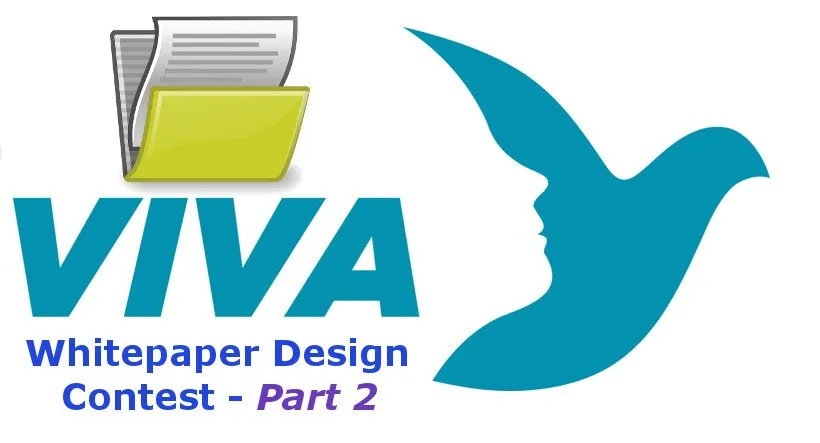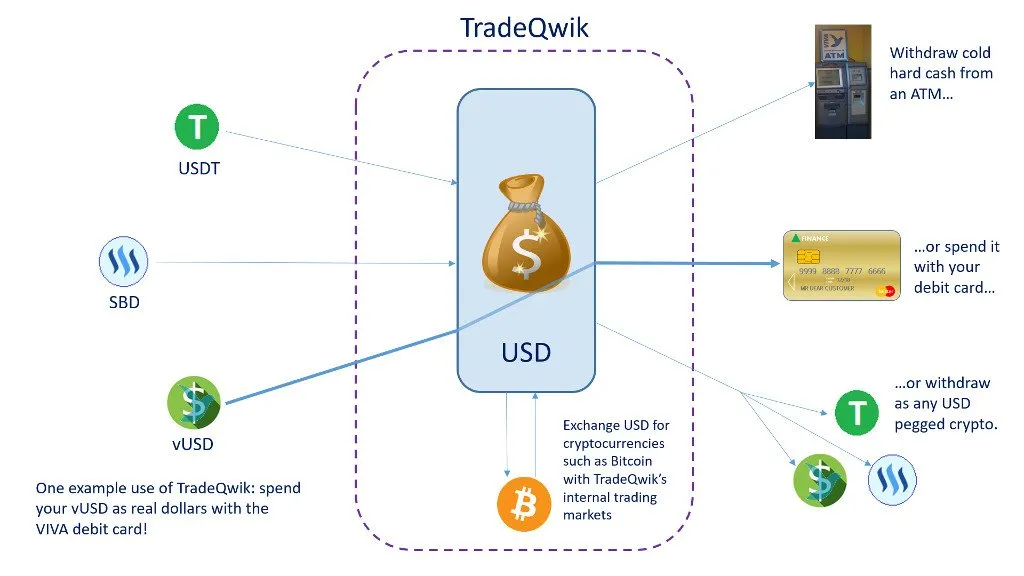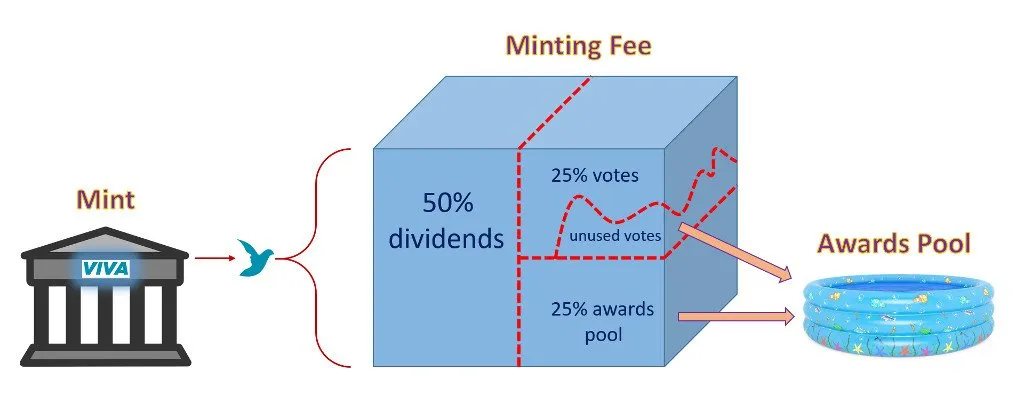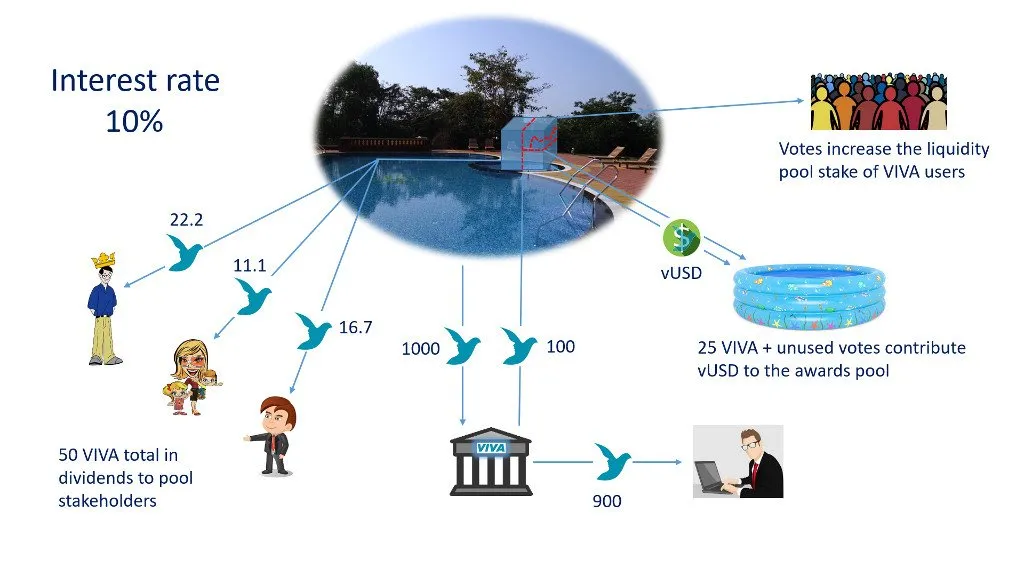
This post is a follow up to my entry in the VIVA whitepaper design contest, a part 2 if you will. In last week's post, @williambanks left a long comment with additional details about how mint interest is used. I've taken that comment and fleshed it out a bit, making it the seed for this post.
But before we get to that, let's take a little detour to introduce another important and relevant part of the VIVA ecosystem:
Getting rid of price volatility with vX
You already know about VIVA Crowns & coins, but there is another type of digital token in the VIVA economic system as well: vX. vX is a currency that is always worth 1 X amount of VIVA coins, where X can be anything capable of being reliably priced. For example, vUSD for units of US dollars, vMXN for units of Mexican pesos, or even vXAU for mg of gold.
1 vUSD will always be redeemable for $1 worth of VIVA coins, regardless of the current price of VIVA. This makes it easier to spend your money. You don't have to worry that the price of VIVA tomorrow might not be what it is today. You always know that you've got $1 worth of purchasing power, no matter what.
Steemit users are already familiar with this concept, because it's just like how SBD (Steem-backed Dollars) works. In fact, it's fair to say that 1 SBD = 1 vUSD = $1.
The TradeQwik exchange takes this concept a step further, allowing fiat currency to mix freely (be completely fungible) with its pegged digital asset equivalents. For example, when you deposit vUSD or SBD on TradeQwik, it's just counted as USD, which you can withdraw as cold hard cash at an ATM or spend with the debit card linked to your account.
Thus the use of vX allows people to seamlessly spend their VIVA earnings outside the digital world.
Figure 9: TradeQwik is a melting pot where fiat pegged digital currencies can be mixed & matched to your heart's content.

Giving away money through votes
Now that we know about vX, we are in a position to revisit the concept of mint interest that was discussed last week. As mentioned previously, crownholders collectively set an interest rate that determines the fee mints are required to pay for the privilege of minting new VIVA coins. 50% of this fee is distributed to liquidity pool stakeholders in the form of dividends. But what happens to the rest of it?
Well, the simple answer is: 25% gets allocated to the awards pool (more on that a bit later), and the remaining 25% gets allocated according to user voting, with any unused votes also contributing to the awards pool.
Voting is similar in concept to the way you vote for posts on Steemit to award post authors a chunk of the daily Steem rewards allotment. But there are some key differences. Let's do a comparison:
| Steemit | VIVA |
|---|---|
| Vote on posts | Vote on user accounts (not actual content per se) |
| Get rewards in Steem / Steem Power / SBD | Get rewards in liquidity pool stake |
| Users can vote as often as they like (with diminishing effect for voting too frequently) | Users have a fixed number of votes per day, which is determined by how much stake they have in the liquidity pool |
| Votes have a variable value depending on your Steem Power and how other people vote | All votes have the same dollar value (set by crownholders) |
| Has curation rewards | No curation rewards |
Voting is a mechanism by which you can reward VIVA community members for any actions that you deem worthwhile. And since you are voting on accounts, not specific content, applicability of votes is much more general than Steemit. Do you know someone who produces wonderful videos on YouTube, runs a particularly reliable worker node for a business, or helps provide liquidity to thin markets on TradeQwik? Then toss a vote their way and show them their efforts are appreciated!
There will even be a VIVA browser plug-in so that when you vote for a post on Steemit, you also vote for that user in VIVA if they happen to have a VIVA account named the same as their Steemit account. It's easy to imagine similar plug-ins being developed for other social sites such as YouTube, Reddit, etc.
A few important points:
All votes contribute to a user's liquidity pool account, meaning that votes increase a person's percentage ownership of the liquidity pool rather than being paid out directly in VIVA coins.
Votes are use-it-or-lose it. If I have 5 votes per day, and I only use 3 of them, then the 2 unused votes don't carry over to the next day. I just lose them.
Nothing in VIVA is wasted. If I have 2 unused votes leftover at the end of the day, they would get sent to the awards pool.
Figure 10: Minting fees are allocated to dividends, user votes, and the awards pool.

We can now go back and give a more complete picture of the 10% interest rate example shown last week:
Figure 11: Cash flows generated throughout the VIVA ecosystem by the minting process.

The 50-25-25 split shown above will be the initial ratio when VIVA launches, but as with other economic parameters, the crownholders are able to vote on changing these numbers according to the needs of the system at any given time. So it's important to realize this ratio is not set in stone.
Award Rights & the VIVA awards pool
Every 90 days, crownholders can perform these actions for each Crown they own:
Sell (rent out) a Treasury Right (TR) to a mint, or sink a TR into the liquidity pool (thereby purchasing additional ownership stake in the pool).
Give an Award Right (AR) to any VIVA user.
TRs and ARs can be used independently of each other, and mixed in whatever measure is desired depending on how many Crowns you have. For example, if I had 10 Crowns I could choose to rent out 3 TRs, sink 7 TRs in the liquidity pool, and issue 4 ARs to deserving users, all for the same 90 day period (not all ARs have to be used).
You are already familiar with TRs, but we haven't talked about Award Rights yet. Like TRs, an AR is good for a 90 day period and then it expires, allowing you to issue another one. The purpose of ARs is to allow crownholders to award people a potentially life changing amount of money, above and beyond what simple voting can accomplish.
Is there an aspiring musician you just know would take off, if she could just stop working 80 hours a week as a waitress? Is there an artist you believe has the potential to be the next Picasso? Then issue them an AR, and let other crownholders know so they can also issue ARs, with the aim of giving the beneficiary a jumpstart on escaping the daily grind in order to pursue his or her true passions.
Sounds great in theory. How does it work in practice?
This is where the awards pool comes in. As mentioned above, 25% of minting fees plus all unused daily votes go to the awards pool, which stores them as vUSD. This vUSD is allowed to accumulate over a 90 day period. At the end of the 90 days, the pool is drained: all the vUSD is converted back into an equivalent amount of VIVA coins and distributed in the form of liquidity pool stake to everyone who was granted an AR during that particular 90 day period. Then another 90 day period begins, with the awards pool balance reset back to 0. Note that at no time is the market being flooded with extra VIVA; all the coins in this process are destroyed in the liquidity pool and only pool ownership is affected accordingly.
The recipients of the ARs will then be able to claim dividends for life in the usual manner, based on their awarded liquidity pool stake.
Awards for each 90 day period are granted in a proportional fashion depending on how many ARs an individual was granted during that period vs. the total number of ARs granted.
For example, let's imagine that during a particular period, 500,000 vUSD accumulates in the awards pool, and crownholders issue 100 ARs. Susie Soccermom, a single mother with 2 kids, struggles to make ends meet and runs a worker node for a business to generate some extra income on the side. She's also a popular science blogger, but doesn't have enough time to write frequently. Some of her friends, who are also the crownholders that introduced her to VIVA in the first place, decide to help her out. Collectively they issue her 5 ARs.
Figure 12: Using Award Rights to be a good philanthropist.

As there are 100 ARs total for this period, each AR is worth 1% of the awards pool which is 5000 vUSD. So Susie's stake in the liquidity pool will increase by $25,000 worth of VIVA coins, giving her quite a boost in future dividends. With the extra money she doesn't have to work as much and can concentrate on her dream of being a professional writer.
There are a few more subtle details to take note of:
Awards issued via ARs are capped at a maximum of 1% ownership of the liquidity pool, to prevent ownership from becoming unbalanced.
If a 90 day period ends with no ARs being issued, the ending balance of vUSD in the awards pool gets rolled over to the next 90 day period (the awards continue to build up until there is at least one person to claim them).
The cutoff for issuing ARs is 7 days before the end of the awards period. This means people can't game the system by sneaking in ARs at the last minute.
If a Crown is currently in debt to the liquidity pool due to negative interest (see the "Negative stakes" section of last week's post if you need a refresher on this), then the Crown cannot issue any ARs. But a crownholder with negative stake can still be an awards recipient; in this case the award received will first be used to pay off the debt to the liquidity pool and boost the recipient's stake into positive territory again.
I love the idea of helping as many people as possible, but what if I'm too busy to find worthy AR candidates?
Never fear, you can designate any VIVA user as a proxy to hand out your ARs for you. It's easy to imagine a whole cottage industry springing up, centered around professional philanthropic scouts dedicated to searching out & vetting candidates for awards on behalf of the crownholders.
VIVA sounds awesome! How can I be a part of it?
Feel free to join the VIVA community at https://chat.vivaco.in/home . I've found the VIVA team is very friendly and always willing to discuss any questions you may have.
The system is not fully live yet, although parts of it are up and running in beta testing, notably the TradeQwik exchange. It's an exciting time and watching the day-to-day progress feels like witnessing history in the making! Now is a perfect time to get involved.
Looking forward to seeing you there. Until then, keep calm and Steem on!
Links for further study
Read about the whitepaper contest here (there is still time if you want to enter the contest yourself!): https://steemit.com/contest/@vivacoin/viva-contest-so-you-think-you-can-graphic-artz
The first part of my entry in the whitepaper contest: https://steemit.com/vivacoin/@cryptomancer/my-entry-in-the-viva-whitepaper-contest
A comprehensive introduction to VIVA by @sykochica : https://steemit.com/vivacoin/@sykochica/have-you-heard-about-vivacoin
VIVA essential references by @williambanks :
- Part 1 - Introduction to VIVA : A Price Stable Crypto Currency with Basic Income
- Part 2 - More than meets the eye
- Part 3 - How does it work?
- Part 4 - How do you bootstrap a new economy?
- Part 5 - VIVA CAN? You bet!
Join the TradeQwik beta: https://www.tradeqwik.com/
For more posts about cryptocurrency, finance, travels in Japan, and my journey to escape corporate slavery, please follow me: @cryptomancer
Image credits: VIVA logo used in the title image & diagrams is the original creation of the VIVA team. ATM picture also courtesy of the VIVA team. SBD coin image is modified from a screen shot of the Steemit logo taken from the Steemit web site. All other clip art comes from Pixabay and is used under Creative Commons CC0. The diagrams themselves are my own creation, built using Microsoft PowerPoint.

Achievement badges courtesy of @elyaque . Want your own? Check out his blog.